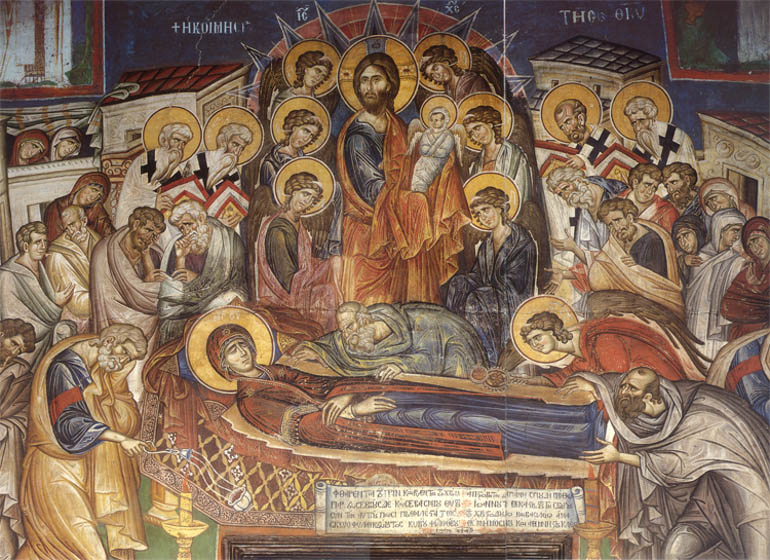- Home
- About us
- Students
- Courses
- Research
- Library
- News & Events
- Gallery
- Contact
- Our Blog
Latest News

The Feast of the Dormition of the Theotokos

Rejoice, the dawn of the mystical day
Χαῖρε ἡ αὐγῆ τῆς μυστικῆς ἡμέρας
Akathist Hymn
In you the laws of nature are defeated… death introduces life
Νενίκηνται τῆς φύσεως οἱ ὅροι, ἐν σοὶ Παρθένε ἄχραντε...
ζωήν προμνηστεύετεαι θάνατος.
Ninth Ode, Katabasia, Orthros Service
by Assoc. Professor Philip Kariatlis (Sub-Dean)
Without doubt in the Eastern Orthodox tradition, “our glorious Lady Theotokos”, has a pre-eminent place in the life of the Orthodox Church. The month of August, for example, is dedicated to the Virgin Mother, not to mention other great feasts that are celebrated throughout the entire liturgical year. Not only do we celebrate the Dormition (or Falling Asleep) of the Theotokos [1] in August, but there are Supplication Services which are held every day in the first two weeks of this month leading to the great feast, as well as the designated period of fasting which the Church has prescribed. This betrays both the great devotion attributed to the blessed Mother personally by the faithful of the Church throughout the ages—and rightly so, since we read in the Gospel according to St Luke: “Surely, from now on, all generations will call me blessed” (Lk 1:48)—and the extent to which her person has infused Orthodox spirituality.
In celebrating the Dormition (or ‘Falling Asleep’) of the Mother of God, it is very often thought that the Church honours the ‘end’ of Mary’s life. Looking however at the various hymns ascribed to this day, we discover that it is the very beginning of her life that is celebrated—namely, her entrance into eternal blessedness! This inexplicable and wondrously paradoxical notion of death as entrance into life permeates the entire hymnology of this significant Feast Day: The Vesperal hymns, for example, begin with, “Marvel at the wondrous mystery [Ὤ τοῦ παραδόξου θαύματος…], the fount of life has been laid in a tomb and yet her tomb has become a ladder to heaven above”; in the dismissal hymn of the day, the Church sings: “In your falling asleep, O Theotokos… you were transported to life [Ἐν τῇ κοιμήσει… μετέστης πρὸς τὴν ζωήν].”
In depicting the events leading to Mary’s dormition, the Doxastikon of the Orthros Service begins with this seemingly non-sensical notion that, in the case of the Virgin Mother, death, is ‘deathless’: “At you deathless Dormition [Τῇ ἀθανάτῳ σου Κοιμήσει…], O Theotokos and Mother of Life, clouds caught the Apostles up into the air; and, from being dispersed throughout the world, they were reunited before your immaculate body.” In observing this important Feast Day to the Theotokos, we see that death becomes the means through which the Virgin Mother truly lives. It is precisely for this reason, that the Dormition is cause for celebration, cheer, merriment, and solemn joy since we see the reality of life beyond the grave.
Reflecting a little further we see that, whereas death and life are irreconcilable notions for the world, for our Virgin Mother, on the other hand, death is but a gateway through which she enters into the unfading and resplendent Light of eternity; there, to be forever reunited with her Son, our Lord and Saviour Jesus Christ. Indeed, there, forever to pray on our behalf to her Son and Saviour of the world for the salvation of our souls. The profoundly beautiful Doxastikon of Vespers—sung in all the eight tones of Byzantine chant—asks:
“as you now live forever with the life-bearing King who is your Son, intercede unceasingly [πρέσβευε διηνεκῶς], that He may guard us, your children, and that He may save us from every hostile assault, since we are under your protection.”
If by the Cross of Jesus Christ, and his resurrection from the dead, death is conquered and the victory of undying life is universally bestowed upon the world, in the person of the Virgin Mother we behold this abiding and boundless gift of unending blessedness personally received, embraced and appropriated by Mary in her life. Indeed, having lived her entire life in the presence of, and united—heart and soul—with her Son and Saviour, her ‘death’ was shown to be a final passageway, a culminating moment for that which she truly longed—forever to be with her Son and Saviour of the world.
The Feast Day of the Dormition is a most compelling reminder of the hope with which we too are called to live, in this transient and fleeting life. In the same way that, in the case of the Virgin Mother, death was experienced as life, so too can this become our experience as well in our ‘final’ moments here on earth. That is to say, in having the Mother of God as our pre-eminent example in this life—to the extent that She truly embodies what it means to live a Christ-loving and Christ centred life—we too are able to live with the future hope of our Lord’s gift and promise of unending life to us, to the extent, of course, that we truly desire and seek to live by His love—in all that we do—in this life.
Through her ‘death’, the Virgin Mother provides the much-needed confidence and conviction that death can in fact become an act of truly living for all. What’s more, death need not be understood as that harrowing moment when we are plunged into soul-destroying darkness and horrifying non-existence; on the contrary, our physical death, as it was for our Virgin Mother, so it can become for us, a passageway into life and into our Lord’s eternal kingdom where His loving presence and embrace will forever reign; and where His unfading and resplendent light with eternally shine.
For the saints of the Church, for whom Christ was literally, truly everything—and here we are reminded of St Porphyrios who would often say, “ὁ Χριστός εἶναι τό πᾶν [Christ is everything]”—death was precisely seen in these terms. And so, for example, St Ignatius the God-bearer (d. ca 110AD), upon his impending death, urged his disciplines not to prevent him from dying at his impending martyrdom. In accord—one could say—with the Virgin Mary’s vision of death, in his letter to the Romans, St Ignatius wrote in a profoundly powerful way about death as true life:
“hinder me not from living, do not wish to keep me in a state of death; and while I desire to belong to God, do not give me over to the world. Allow me to obtain the pure light [μὴ ἐμκοδίσητέ μοι ζῆσαι, μὴ θελήσητέ με ἀποθανεῖν τὸν Θεὸν θέλοντα εἶναι, κόσμῳ μὴ χαρίσητε. Ἄφετέ με καθαρὸν φῶς λαβεῖν]. ”[2]
It is precisely for this reason that, in quietly pondering the significance of the Dormition, may we be reminded of, and discern, the ‘deathlessness of death’; may we be overcome with an intense sense of calm and serenity; joy and blessedness; delight and radiance, beholding death not as a departure and farewell, but, in the case of the Mother of God, her entrance—and by extension ours as well—into the gift of eternal blessedness and life everlasting. In the end, may we also be emboldened to behold death not as separation and rupture but union with Christ and His kingdom.
[1]Even though the historical origins of the feast are vague, already before 500AD, it was being celebrated on the 15 August. It was in the seventh century, that the Byzantine Emperor Maurice officially designated 15 August as the day for celebrating the Dormition of the Theotokos.
[2]St Ignatius of Antioch, Letter to the Roman 6, PG 5: 692BC.



.png)